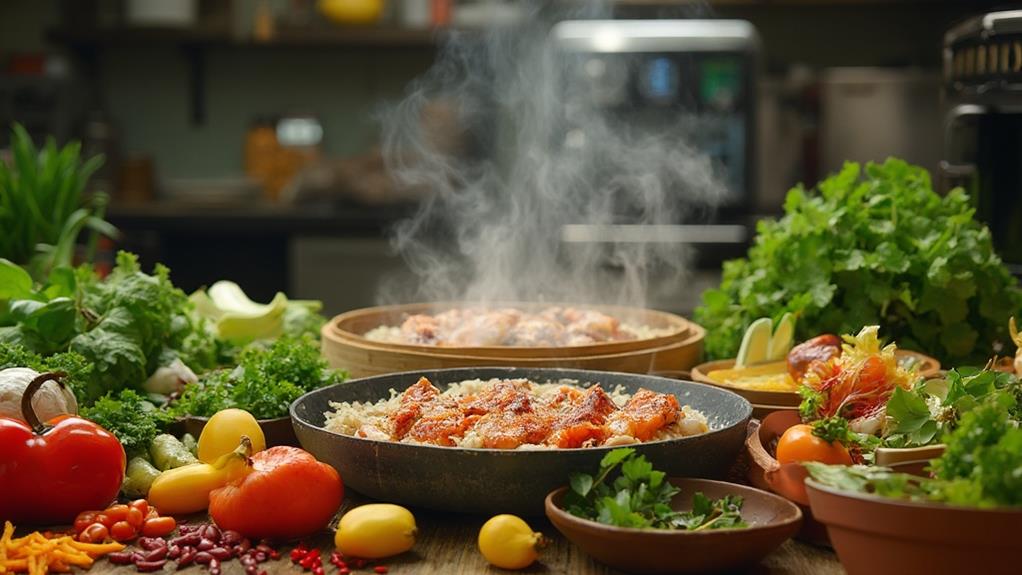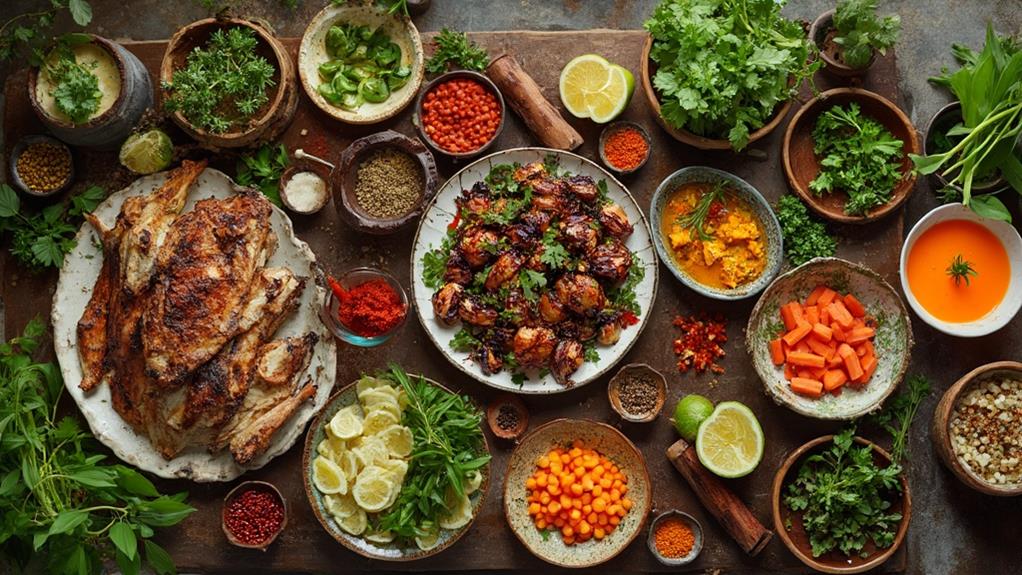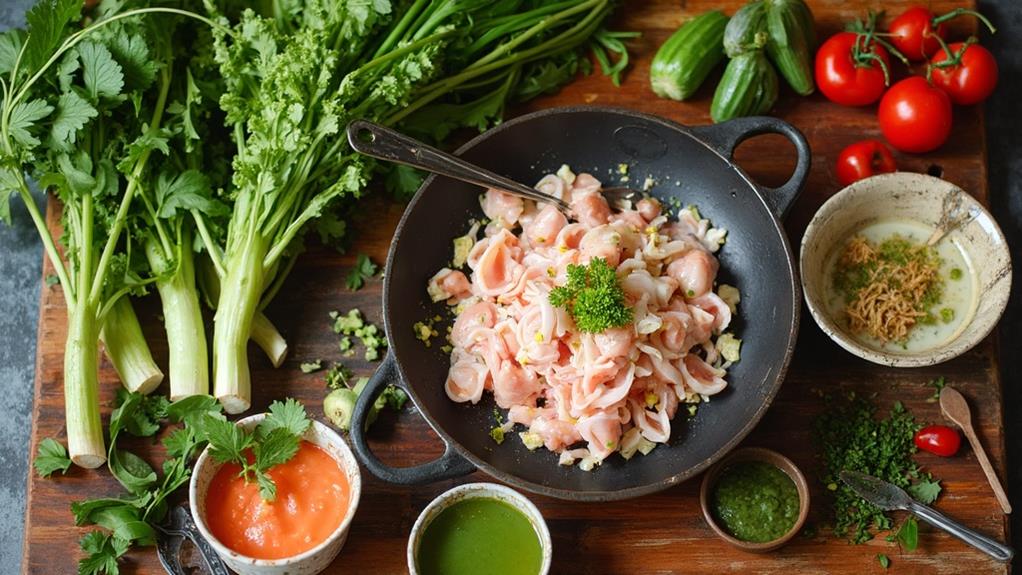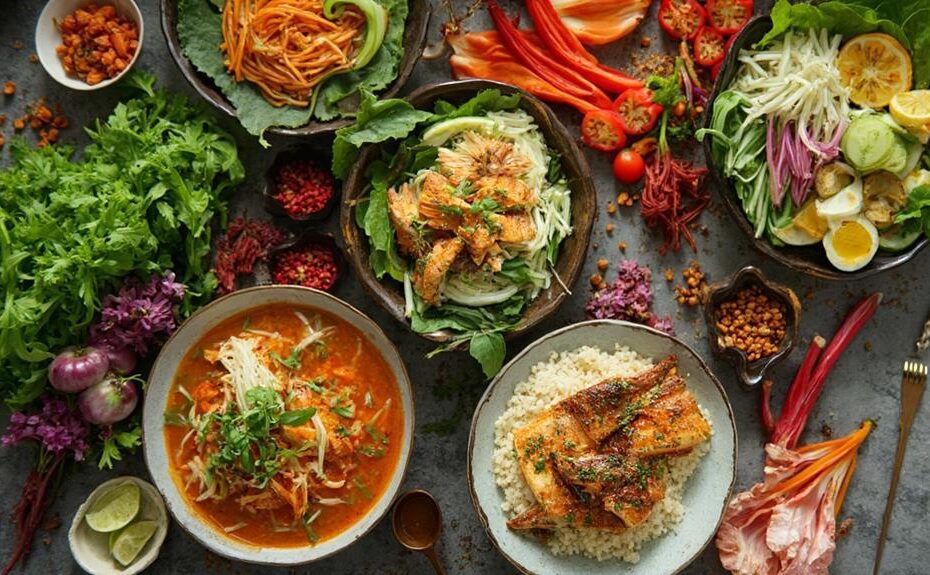Modern Filipino dishes can be adapted to reduce sodium and fat without sacrificing flavor. To achieve this, replace traditional soy sauce with low-sodium soy sauce or tamari, which can significantly reduce sodium content.
Light coconut milk or almond milk can be used as a substitute for regular coconut milk to decrease fat content.
Incorporate more vegetables into your recipes, such as broccoli and bell peppers, to increase nutrient density and fiber content.
Opt for lean proteins like skinless chicken or tofu to reduce saturated fat and cholesterol.
Healthier cooking methods like grilling, steaming, or baking can be used instead of deep-frying to reduce fat absorption.
Enhance flavor with fresh herbs, spices, and citrus juices, which can effectively replace traditional saltiness.
These adjustments ensure vibrant, healthful meals that honor Filipino culture.
Understanding Filipino Cuisine
Filipino cuisine is a unique fusion of flavors and cultural influences. It's rooted in a blend of indigenous, Spanish, Chinese, and American traditions, resulting in a diverse range of cooking methods and ingredients.
Communal dining is an essential part of Filipino culture. Meals are often shared, reflecting the strong emphasis on family and togetherness. This cultural heritage is also highlighted through traditional folk dances, such as Tinikling and Rigodon.
Staple dishes in Filipino cuisine include adobo, sinigang, and lechon. Adobo is a marinated meat dish that can be made with chicken, pork, or even vegetables, showcasing the versatility of the cuisine.
Adobo's regional variations include using different types of vinegar, soy sauce, and spices to create distinct flavor profiles. Sinigang offers a sour flavor profile, typically derived from tamarind, and is packed with fresh vegetables.
Rice is a staple food in Filipino cuisine. It accompanies nearly every meal, serving as a canvas for the vibrant flavors of the main dishes.
Understanding the techniques and ingredients that define Filipino cuisine enables adaptation of recipes for healthier eating, allowing individuals to enjoy the rich heritage while prioritizing their well-being.
Common Ingredients to Reduce
Filipino cuisine can be made healthier by reducing sodium and fat in traditional dishes. Lowering sodium and fat intake can enhance the nutritional profile of meals without sacrificing flavor.
Soy sauce is a common ingredient that can be replaced with a healthier alternative. Using low-sodium soy sauce or tamari reduces salt intake while maintaining flavor. Low-sodium soy sauce has the same taste as regular soy sauce but with less sodium.
Fish sauce is another ingredient that can be swapped with a healthier option. Opting for low-sodium fish sauce reduces sodium content in dishes. Low-sodium fish sauce provides the same umami flavor as regular fish sauce but with less salt.
Coconut milk can be replaced with a lower-calorie alternative. Using light coconut milk or almond milk reduces fat content in recipes. Light coconut milk provides creaminess with fewer calories than regular coconut milk.
Natural sweeteners are a healthier alternative to sugar. Swapping sugar with natural sweeteners like stevia or honey helps manage sugar levels. Natural sweeteners satisfy the sweet tooth while reducing sugar intake.
Healthier Cooking Techniques

Healthier Cooking Techniques for Filipino Dishes
To minimize fat and calorie content while preserving flavor in Filipino dishes, adopt cooking techniques that prioritize nutrition and flavor.
Steaming: A Nutrient-Rich Option
Steaming is an effective method that retains nutrients and enhances natural flavors without adding fats. You can steam vegetables, fish, or even rice, ensuring a light yet satisfying meal.
Grilling for Flavor and Nutrition
Grilling meats and vegetables allows excess fat to drip away while achieving a smoky flavor. Marinate proteins in herbs and spices to elevate taste without relying on heavy sauces.
Stir-Frying with a Twist
Stir-frying with a minimal amount of oil is a smart choice. Use a non-stick pan to reduce the need for added fats, and fill your stir-fry with colorful vegetables and lean proteins for a balanced meal.
Braising and Poaching: Gentle Cooking Methods
Braising or poaching are alternatives to frying that use broth or water to cook food gently, maintaining tenderness without extra calories.
These methods allow for a healthier cooking option while preserving flavor. By incorporating these healthier cooking techniques, you can enjoy the vibrant flavors of Filipino dishes while making mindful choices for your health.
Adapted Recipes for Classics
Opt for Lean Proteins
Use skinless chicken, turkey, or fish as a healthier alternative to fatty meats like pork. This substitution helps reduce saturated fat intake and promotes a leaner diet.
Incorporate Vegetables
Add vegetables to your recipes to boost nutrition and fiber. For example, add spinach to sinigang or bell peppers to adobo to increase the nutritional value of these traditional dishes.
Choose Healthier Cooking Methods
Grill, steam, or bake instead of deep-frying to significantly reduce fat content in your dishes. These alternative cooking methods help retain nutrients and flavors without adding excess oil.
Reduce Added Sugars
Use natural sweeteners like honey or fresh fruits to satisfy your sweet cravings. For instance, try using honey or fresh fruits to sweeten desserts like leche flan instead of refined sugars.
Flavorful Alternatives for Seasoning

Herbs and Spices: A Healthier Alternative to Salt and Processed Seasonings
When it comes to adding flavor to your dishes, herbs and spices are a healthier alternative to salt and processed seasonings. Using natural flavorings can significantly reduce sodium intake while still delivering bold tastes. For example, garlic and onion powder can add a savory depth to many Filipino dishes without excess salt.
Experimenting with Fresh Herbs
Fresh herbs like cilantro, basil, or oregano can add vibrant flavors and essential nutrients to your meals.
A sprinkle of crushed red pepper or a dash of black pepper can elevate the heat and complexity of your dishes.
Umami Flavor Alternatives
For umami flavor, try incorporating nutritional yeast or a splash of low-sodium soy sauce instead of regular soy sauce.
Citrus juices, like calamansi or lime, can brighten up your dishes while adding a refreshing zing.
Vinegar: A Tangy Twist
Consider using vinegar to enhance flavors in marinades and dressings.
Balsamic, apple cider, or cane vinegar can bring a tangy twist that enhances your recipes without relying on salt.
Incorporating More Vegetables
Incorporating Vegetables into Filipino Dishes
Incorporating more vegetables into your Filipino dishes not only boosts nutritional value but also enhances flavor and texture.
Adding a variety of colorful vegetables can create meals that are healthier and visually appealing.
The Importance of Vegetable Intake
Research shows that increasing vegetable intake can lower the risk of chronic diseases and improve overall health. This makes it a smart choice for everyone.
Inspiration from Filipino Cultural Heritage
Traditional Philippine folk dances like the Pandanggo, which highlights the grace and elegance of the Filipina dancer, often feature vibrant colors and intricate designs that can inspire a variety of colorful vegetables in your meals.
Similarly, the Tinikling dance, which requires agility and grace, can motivate you to incorporate more movement and exercise into your daily routine, such as taking a short walk after meals.
Ways to Incorporate Vegetables
Sautéed Greens: Mix in leafy greens like spinach or kangkong with your stir-fries and stews for a nutrient-packed boost.
Vegetable Medleys: Prepare a variety of vegetables such as bell peppers, carrots, and zucchini to accompany your main dishes, adding both color and crunch.
Soups and Stews: Incorporate root vegetables like sweet potatoes and carrots into your favorite sinigang or pinakbet recipes for added depth and nutrition.
Cauliflower Rice: Substitute traditional rice with cauliflower rice in your adobo or fried rice dishes to cut down on carbs while increasing fiber intake.
Tips for Meal Preparation

Meal planning is essential for healthy meal preparation. A weekly meal plan helps you choose a variety of colorful vegetables, lean proteins, and whole grains, reducing food waste and ensuring healthier choices. For example, plan to include vegetables like broccoli, carrots, and bell peppers, lean proteins like chicken, fish, and tofu, and whole grains like brown rice, quinoa, and whole wheat.
Batch cooking saves time and energy. Cooking large portions of grains or proteins and storing them in the fridge or freezer allows for quick meal assembly. For instance, cook a large batch of brown rice or quinoa and store it in the fridge for up to 5 days. Similarly, cook and store proteins like chicken or beans for easy addition to meals.
Prepping ingredients is crucial for healthy meal preparation. Wash, chop, and store vegetables in clear containers, making them easily accessible for snacks or meal prep.
Use healthy cooking methods like steaming, grilling, or baking to reduce added fats. For example, steam broccoli instead of sautéing it with oil, or grill chicken instead of frying it.
